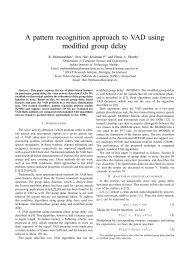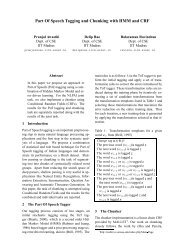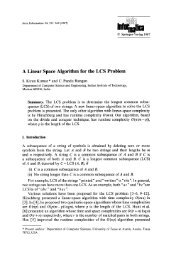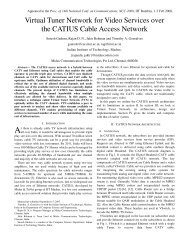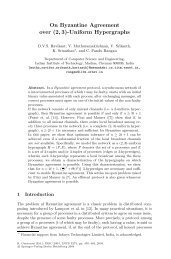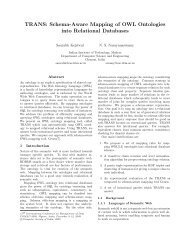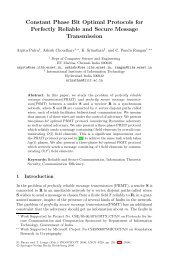Representation of Images Through Group-Delay ... - IEEE Xplore
Representation of Images Through Group-Delay ... - IEEE Xplore
Representation of Images Through Group-Delay ... - IEEE Xplore
Create successful ePaper yourself
Turn your PDF publications into a flip-book with our unique Google optimized e-Paper software.
238 <strong>IEEE</strong> TRANSACTIONS ON ACOUSTICS. SPEECH, AND SIGNAL PROCESSING, VOL. ASSP-35, NO. 2, FEBRUARY 1987functions which <strong>of</strong>fer insight into the problem <strong>of</strong> image reconstruction.1) For a minimum phase signal, rm(w) = rp(w).2) For a maximum phase signal, r,(w) = -rp(w).3) For a mixed phase signal, lrm(w) I # 1~Jw)l.A mixed phase signal can be thought <strong>of</strong> as a convolution (in thetime domain) <strong>of</strong> its minimum and maximum phase components.This corresponds to addition in the group-delay domain.We develop the group-delay functions applicable for two-dimensionalsignals in Section 11, and discuss algorithms for theircomputation and for the recovery <strong>of</strong> images from them. We giveseveral examples <strong>of</strong> images (each 32 X 32 pixels) recovered fromtheir group-delay functions to demonstrate the validity <strong>of</strong> this representation.In Section I11 we derive the minimum phase equivalentimages from spectral magnitude and from phase through their respectivegroup-delay functions. We compare these images to thoseobtained through iterative reconstruction from the Fourier transformmagnitude and phase, respectively.11. THEORY OF GROUP-DELAY FUNCTIONSAn image is a two-dimensional signal represented as a two-dimensionalsequence or numbers x(nl, n,), nl = 0,1,2, . . ,N, - 1, and n2 = 0, 1, 2, . * . , N2 - 1. The Fourier transform <strong>of</strong>{x(nl, n2)} is given byNI-1 N2-1where O(w,, w2) is the principal value <strong>of</strong> phase and h(q, w2) is aninteger such that the overall phase becomes a continuous function<strong>of</strong> w1 and w,. The function4(wI, w2) = e(w,, w2) + NU,, w2) (2)is called the unwrapped phase function. It is assumed that IX(wl,w2)I # 0 for all w1 and w,. Consequences <strong>of</strong> this assumption willbe discussed later.Since there are two freqeuncy variables w, and w2, we definetwo group-delay functions from phase as follows:(a)Fig. 1. Image reconstruction from group-delay functions: example 1. (a)Original (32 X 32). (b) Signal reconstructed from group-delay functions.4) Compute the Fourier transforms <strong>of</strong> these two sequences toobtain r,, and rm2, respectively.To recover the spectral magnitude from rml and rm2, we combinethe two sets <strong>of</strong> cepstral coefficients [7] derived from r,, and T,~,respectively, and then compute the Fourier transform which yieldsthe log magnitude. The steps involved in the computation <strong>of</strong> thespectral magnitude from rml and rm2 are as follows.1) Compute {nlcl(nl, n,)} and {n2c2(nl, n,)}, the inverse Fouriertransform <strong>of</strong> r,] and rm2, respectively.2) Form the sequences (cl(nl, nz)] and {c2(nl, n2)} and makethem even symmetric.3) Compute the cepstral coefficients as follows.a) The first row <strong>of</strong> cepstral coefficients consists <strong>of</strong> those de-rived from rm2 in steps l) and 2).b) The first column <strong>of</strong> cepstral coefficients consists <strong>of</strong> thosederived from r,, is steps 1) and 2).c) The rest <strong>of</strong> the two-dimensional array is computed as theaverage <strong>of</strong> the two sets <strong>of</strong> cepstral coefficients.4) Take the inverse Fourier transform <strong>of</strong> the cepstral coefficientsto get the log magnitude. Exponentiate it to obtain the spectralmagnitude.Computation <strong>of</strong> rpl, and 7 is similar to the one-dimensional case,p?the algorithm for which is glven in [5]. The algorithm is based onthe following relations.(b)Although minimum phase function in two dimensions is not well where Y, is the Fourier transform on {nlx(nl, n,)] and Y2 is theunderstood, we use the term analogous to one-dimensional thecase. Fourier transform <strong>of</strong> {n2n(nl, n,)}. The subscript R stands for theIn particular, we call the phase function derived from the FT mag- real part <strong>of</strong> the Fourier transform and the subscript I stands for thenitude as the minimum phase function, and the signal obtained from imaginary part <strong>of</strong> the Fourier trasnform. The average values <strong>of</strong> thethe FT magnitude and the minimum phase function as the minimum group-delays rpl and rp2 give the linear phase components in thephase equivalent signal from spectral magnitude. Let +min(~I, w2) unwrapped phase function 4(wI, w2) along the axes w1 and w,, rebethe unique minimum phase function corresponding to I X(wl, spectively.w2)I, then we define two group-delay functions from +min(~l, w2) Recovery <strong>of</strong> phase from T~~ and rp2 is similar to the algorithmas follows:given above for recovering the log magnitude, with the differencethat we make the cepstral coefficients derived from the group-delayfunctions odd symmetric about the origin. Linear phase terms haveThe term “unique minimum phase function” is used here in thesense that the cepstral coefficients {c(nl, n2)} derived from lnjX(wl,w2) I determine the magnitude and phase functions completely. Wenow describe algorithms to compute the two-dimensional groupdelayfunctions. The algorithms are based on the computation <strong>of</strong>the cepstral coefficients used in [6] and [7]. The algorithm for thecomputation <strong>of</strong> rml and rm2 thus consists <strong>of</strong> the following steps.1) Compute X(w,, w2), the Fourier transform <strong>of</strong> (x(nl, n2)>.2) Take the inverse Fourier transform <strong>of</strong> lnlX(ol, wz)l to obtain{c(nl, n2)}, the cepstral coefficients. Note that whenever IX(wl,w2)1 5 E , then IX(wl, 02)1 is set equal to E, where E is a smallpositive quantity.3) Form the two-dimensional sequences (nlc(nl, n2)} and(n2c(nl, n,)} and make them even symmetric about the origin.to be added along the two axes to recover the phase from the groupdelayfunctions.Fig. l(a) shows a picture, and Fig. l(b) shows the image reconstructedfrom the group-delay functions derived from the originalpicture. We notice that the reconstructed image looks almost likethe original. Figs. 2 and 3 show the original and the reconstructedimages for two other pictures. These examples demonstrate that thegroup-delay representation is adequate for a wide variety <strong>of</strong> pictures,despite the problems in computing the group-delay functionsfor real signals due to very small values <strong>of</strong> 1x1 at some frequencypoints.111. MINIMUM PHASE EQUIVALENT IMAGESWe propose in this section noniterative algorithms for the reconstruction<strong>of</strong> the minimum phase equivalent images from spectralmagnitude or phase.



